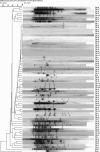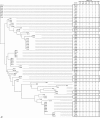Comparison of a variable-number tandem-repeat (VNTR) method for typing Mycobacterium avium with mycobacterial interspersed repetitive-unit-VNTR and IS1245 restriction fragment length polymorphism typing
- PMID: 19403768
- PMCID: PMC2708485
- DOI: 10.1128/JCM.02373-08
Comparison of a variable-number tandem-repeat (VNTR) method for typing Mycobacterium avium with mycobacterial interspersed repetitive-unit-VNTR and IS1245 restriction fragment length polymorphism typing
Abstract
Mycobacterium avium complex (MAC) infections are increasing annually in various countries, including Japan, but the route of transmission and pathophysiology of the infection remain unclear. Currently, a variable-number tandem-repeat (VNTR) typing method using the Mycobacterium avium tandem repeat (MATR) loci (MATR-VNTR) is employed in Japan for epidemiological studies using clinical isolates of M. avium. In this study, the usefulness of this MATR-VNTR typing method was compared with that of the IS1245-restriction fragment length polymorphism (IS1245-RFLP) typing method and a mycobacterial interspersed repetitive-unit (MIRU)-VNTR typing method reported previously (V. C. Thibault, M. Grayon, M. L. Boschiroli, C. Hubbans, P. Overduin, K. Stevenson, M. C. Gutierrez, P. Supply, and F. Biet, J. Clin. Microbiol. 45:2404-2410, 2007). Seventy clinical isolates identified as M. avium from human immunodeficiency virus-negative patients with MAC infections were used. MATR-VNTR typing using 15 loci distinguished 56 patterns of different allele profiles, yielding a Hunter-Gaston discriminatory index (HGDI) of 0.990. However, IS1245-RFLP and MIRU-VNTR typing yielded HGDIs of 0.960 and 0.949, respectively, indicating that MATR-VNTR has an excellent discriminatory power compared with MIRU-VNTR and IS1245-RFLP typing. Moreover, concomitant use of the MATR-VNTR method and IS1245-RFLP typing increased the HGDI to 0.999. MATR-VNTR typing is inexpensive and easy to perform and could thus be useful in establishing a digital multifacility database that will greatly contribute to the clarification of the transmission route and pathophysiology of M. avium infections.
Figures



Similar articles
-
[Genetic research about Mycobacterium avium complex].Kekkaku. 2011 Feb;86(2):61-8. Kekkaku. 2011. PMID: 21404652 Japanese.
-
Determination of genotypic diversity of Mycobacterium avium subspecies from human and animal origins by mycobacterial interspersed repetitive-unit-variable-number tandem-repeat and IS1311 restriction fragment length polymorphism typing methods.J Clin Microbiol. 2010 Apr;48(4):1026-34. doi: 10.1128/JCM.01869-09. Epub 2010 Jan 27. J Clin Microbiol. 2010. PMID: 20107094 Free PMC article.
-
Genetic research about Mycobacterium avium complex.Kekkaku. 2013 Jan;88(1):17-22. Kekkaku. 2013. PMID: 23513564
-
[New era in molecular epidemiology of tuberculosis in Japan].Kekkaku. 2006 Nov;81(11):693-707. Kekkaku. 2006. PMID: 17154049 Review. Japanese.
-
Molecular epidemiology of Mycobacterium tuberculosis in Brazil before the whole genome sequencing era: a literature review.Mem Inst Oswaldo Cruz. 2021 Mar 15;116:e200517. doi: 10.1590/0074-02760200517. eCollection 2021. Mem Inst Oswaldo Cruz. 2021. PMID: 33729319 Free PMC article. Review.
Cited by
-
In vitro activity of amikacin against isolates of Mycobacterium avium complex with proposed MIC breakpoints and finding of a 16S rRNA gene mutation in treated isolates.J Clin Microbiol. 2013 Oct;51(10):3389-94. doi: 10.1128/JCM.01612-13. Epub 2013 Aug 14. J Clin Microbiol. 2013. PMID: 23946523 Free PMC article.
-
Molecular typing of Mycobacterium kansasii using pulsed-field gel electrophoresis and a newly designed variable-number tandem repeat analysis.Sci Rep. 2018 Mar 13;8(1):4462. doi: 10.1038/s41598-018-21562-z. Sci Rep. 2018. PMID: 29535391 Free PMC article.
-
MGIT Enriched Shotgun Metagenomics for Routine Identification of Nontuberculous Mycobacteria: a Route to Personalized Health Care.J Clin Microbiol. 2023 Mar 23;61(3):e0131822. doi: 10.1128/jcm.01318-22. Epub 2023 Feb 22. J Clin Microbiol. 2023. PMID: 36840602 Free PMC article.
-
Mycobacterium avium in Community and Household Water, Suburban Philadelphia, Pennsylvania, USA, 2010-2012.Emerg Infect Dis. 2019 Mar;25(3):473-481. doi: 10.3201/eid2503.180336. Emerg Infect Dis. 2019. PMID: 30789130 Free PMC article.
-
Genotyping of swine Mycobacterium avium subsp. hominissuis isolates from Kyushu, Japan.J Vet Med Sci. 2019 Aug 9;81(8):1074-1079. doi: 10.1292/jvms.19-0048. Epub 2019 Jun 3. J Vet Med Sci. 2019. PMID: 31155550 Free PMC article.
References
-
- Bull, T. J., K. Sidi-Boumedine, E. J. McMinn, K. Stevenson, R. Pickup, and J. Hermon-Taylor. 2003. Mycobacterial interspersed repetitive units (MIRU) differentiate Mycobacterium avium subspecies paratuberculosis from other species of the Mycobacterium avium complex. Mol. Cell. Probes 17157-164. - PubMed
-
- Griffith, D. E., T. Aksamit, B. A. Brown-Elliott, A. Catanzaro, C. Daley, F. Gordin, S. M. Holland, R. Horsburgh, G. Huitt, M. F. Iademarco, M. Iseman, K. Olivier, S. Ruoss, C. F. von Reyn, R. J. Wallace, Jr., and K. Winthrop. 2007. An official ATS/IDSA statement: diagnosis, treatment, and prevention of nontuberculous mycobacterial diseases. Am. J. Respir. Crit. Care Med. 175367-416. - PubMed
Publication types
MeSH terms
Substances
LinkOut - more resources
Full Text Sources
Molecular Biology Databases

